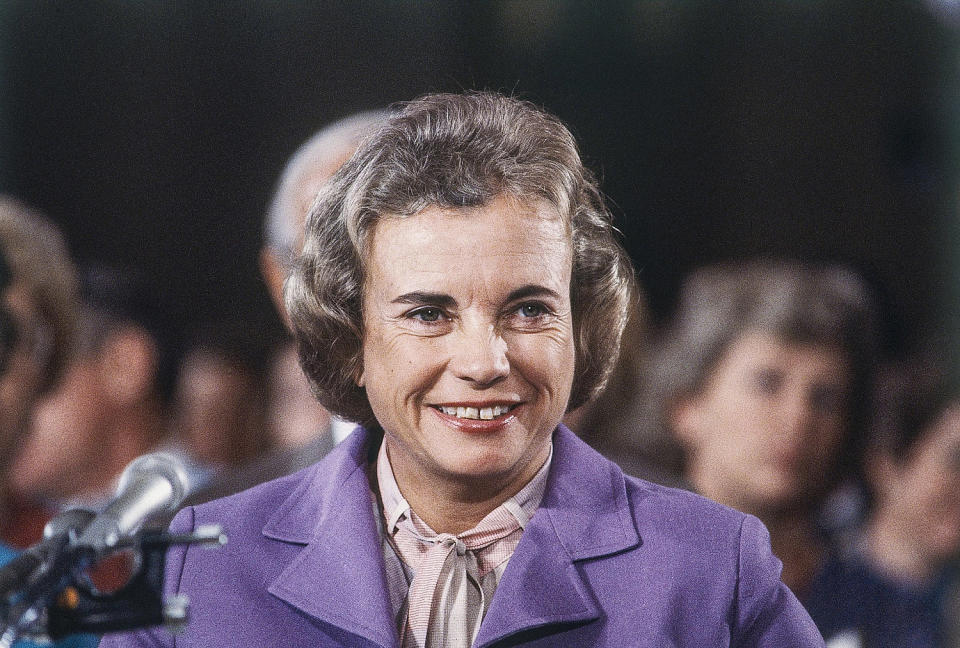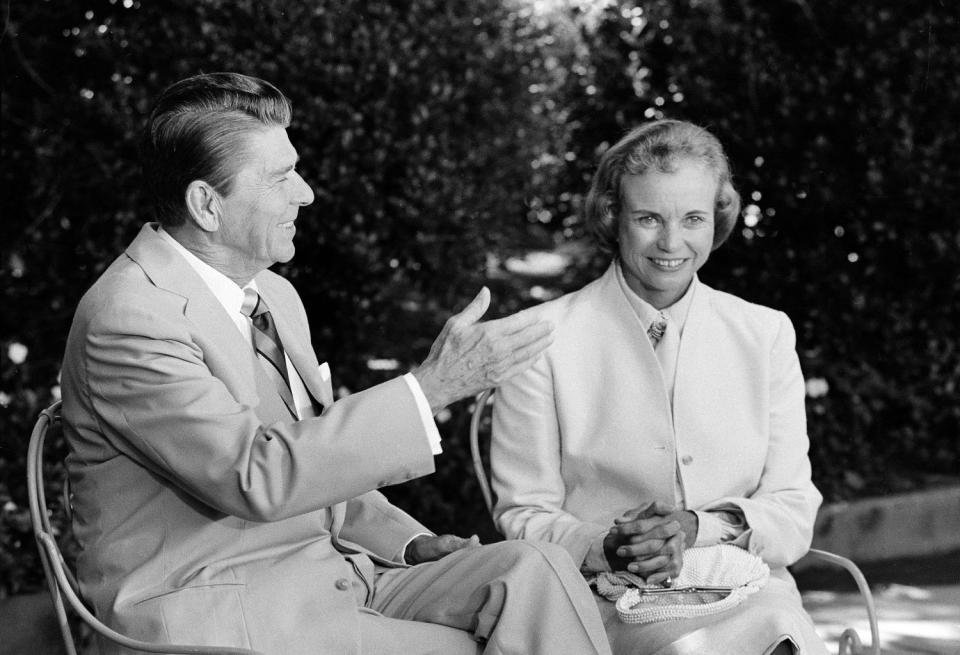Sandra Day O’Connor, the first female Supreme Court justice, dead at 93
- Oops!Something went wrong.Please try again later.
- Oops!Something went wrong.Please try again later.
- Oops!Something went wrong.Please try again later.
- Oops!Something went wrong.Please try again later.
- Oops!Something went wrong.Please try again later.
Sandra Day O’Connor, the first woman to serve on the Supreme Court and the justice who held the court’s center for more than a generation, died Friday, the court said in a statement.
She was 93.
Her cause of death was complications related to advanced dementia and a respiratory illness.
Chief Justice John Roberts said in a statement that O'Connor "blazed an historic trail as our nation's first female justice."
He said the justices "mourn the loss of a beloved colleague, a fiercely independent defender of the rule of law, and an eloquent advocate for civics education."

Other justices were also effusive in their praise, including the four women who currently serve on the court.
Justice Sonia Sotomayor described her as an "American hero" while Justice Elena Kagan said she had a "momentous and inspirational" tenure on the court.
Noting that O'Connor chose not to "mimic the men," Justice Amy Coney Barrett said she showed "remarkable self-confidence and independence." Justice Ketanji Brown Jackson described O'Connor as "full of grace and wit."
From the early 1990s until her retirement in 2006, she was the indisputable swing justice, often casting the deciding vote in the court’s most contentious cases. Her lack of a consistent judicial philosophy rankled some, but others praised her practical bent as a moderating influence.
She sometimes sided with the court’s conservatives, approving taxpayer-funded vouchers for students at religious schools, voting to end the 2000 Florida recount between George W. Bush and Al Gore, and advocating for states’ rights against federal control.
But she joined with the court’s liberals in affirming abortion rights, upholding affirmative action in college admissions, approving the creation of more congressional districts with Black voters in the majority, and keeping a wall of separation between government and religion.
As the court has moved further to the right in recent years, her legacy has been undermined, with the 6-3 conservative majority ending the right to abortion and the consideration of race in college admissions, emphasizing how her modest approach to judging was the hallmark of a different era.
Her reputation as a moderate took a hit when she sided with the conservative justices in the 5-4 Bush. v. Gore ruling, a decision over which she later expressed regrets. The court perhaps should have stayed out of the Florida recount issue altogether, she said in a 2013 interview with the Chicago Tribune editorial board. The ruling, she added, "stirred up the public" and "gave the court a less than perfect reputation."
O'Connor also faced criticism for announcing her retirement in 2005, allowing Bush to replace her with the more aggressively conservative Justice Samuel Alito, who in 2022 wrote the ruling that overturned the abortion rights landmark Roe v. Wade, a step she had been unwilling to take.
O’Connor grew up on the Lazy B, a 160,000-acre cattle ranch in the high desert country straddling the Arizona-New Mexico border. She graduated from law school at Stanford University, where she met her future husband, John, and struck up a lifelong friendship with William Rehnquist, a classmate who would eventually become the nation’s chief justice.
Following four years of service in the Arizona attorney general’s office, she was appointed to fill a vacancy in the state Senate in 1969. After being re-elected, she became the first woman in the country to be a state Senate majority leader.
She then turned her attention to the courts, running for and winning a position as a Maricopa County Superior Court judge.

In 1981, she came highly recommended when President Ronald Reagan was looking for someone to help him keep a campaign promise to appoint a woman to the Supreme Court. She sounded like a conservative during her Senate confirmation hearing, expressing opposition to the notion that the right to abortion was constitutionally protected.
“My own view in the area of abortion is that I’m opposed to it as a matter of birth control or otherwise,” she said. After she was unanimously confirmed, 99-0, she at first criticized Roe v. Wade, but she later joined the court’s majority in a series of cases upholding abortion rights.
As the first female justice, her every action was scrutinized, attention that she would later say was intimidating. “It’s thrilling, in a way, to be the first to do something, the first woman ever to serve on the court. But it’s dreadful if you’re the last. And if I didn’t do the job well, that’s what would happen.”
Seven years after coming to the court, she underwent surgery for breast cancer. Years later, she said the disease “fostered a desire in me to make each and every day a good day.”
She and John O'Connor were married in 1952 and had three children. The O’Connors were frequent guests at Washington social events. An encounter at formal dinner with NFL star John Riggins made national headlines when he told her at one point, “Loosen up, Sandy baby.”
At age 75, O’Connor abruptly announced her intention to step down from the Supreme Court to attend to her husband, who had Alzheimer’s disease. He died in 2009 at age 79.
She remained active, urging states to do away with elections for judges, which she said made the courts too political. And she was outspoken in saying that the nation’s public schools were shirking their responsibility to provide civics education.
O’Connor’s appointment as the first woman justice not only made history, but it also prodded other states to start putting women on their supreme courts. But she recoiled at the thought that a woman would decide cases differently. She was fond of quoting a letter from a supporter who wrote, “Dear Justice O’Connor: Don’t be intimidated by all those men and especially the chief justice. You put on your robes the same way.”
CORRECTION (Dec. 1, 2023, 12:25 p.m. ET): A previous version of this article, in a headline and text, misstated when O’Connor retired. It was in 2006, not 2005.
This article was originally published on NBCNews.com

